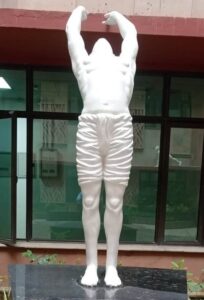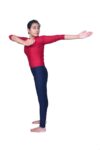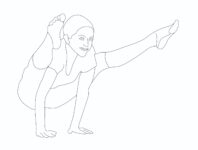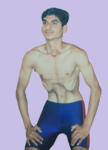Hasta Uttanasana meaning
Hasta Uttanasana, or the Raised Arms Pose Yoga, is a fundamental yoga posture within the sequence of Surya Namaskara (Sun Salutation). Its name is derived from the Sanskrit words “hasta,” meaning hand; “ut,” meaning intense; “tan,” meaning stretch; and “asana,” which means yoga pose.
It is practised as the second and eleventh poses in the Surya Namaskara sequence, symbolising a full body stretch and extension while engaging the breath and mindfulness. Hasta Uttanasana helps to improve posture, increase flexibility in the spine, and promote a sense of openness and energy throughout the body. It is pronounced as ‘hah-stah OOT-tahn-NAHS-uh-nuh’.

How to Do Raised Arms Pose Yoga step by step
- Start in Tadasana: Begin by standing straight with your feet together and your weight evenly distributed on both feet.
- Inhale and raise your arms: Inhale deeply as you slowly raise both arms overhead. As you lift your arms, keep them shoulder-width apart and engage your core muscles to support your spine.
- Lengthen your body: As you reach your arms upward, focus on lengthening your entire body, from your feet to your fingertips. Please make sure that your gaze is forward and your neck is relaxed.
- Gentle backbend: As you inhale, gently arch your upper back, allowing your chest to open. If it feels comfortable, slightly tilt your head backwards, but be cautious not to strain your neck.
- Exhale and return to Tadasana: To release the pose, exhale slowly. Lower your arms back down to your sides in a controlled manner. Return to the Tadasana (Mountain Pose) with your feet together and your body in a neutral, upright position.

Benefits
- The regular practice of it helps to improve digestion.
- It provides adequate stretching and toning to the abdominal muscles
- The practice of this yoga pose ensures the expansion of the chest and the rib cage, thereby full utilisation of oxygen. Thus, the health of the lungs is improved.
- It is suitable for flexibility and mobility, reduces injury chances, and helps eliminate stress.
- It helps avoid cramps and other pains and reduces the chances of injuries.
- It promotes cardiovascular health and prevents hypertension, diabetes and asthma.
Different names
- Raised Arms Pose Yoga
- Hasta Uttanasana
Anuvittasana - Urdhva Vrksasana
- Ardha Chakrasana
Precautions
- Please pay attention to your body’s limitations and bend back as far as you feel comfortable.
- If you have back or neck issues, consult a yoga instructor or healthcare professional before attempting this pose.
- Please maintain proper alignment throughout the pose and avoid overarching the lower back.
Contraindications
- In back pain or stiffness, caution must be taken, and overstretching should be avoided.
- Low blood pressure and dizziness will make you unfit to perform this asana.
- Sciatica and hip injuries require rest, and it is usually recommended that the practice should be avoided in people with these complaints.
- Pregnant and menstruating women should avoid the practice of it.
Modifications & Variations
- If you have tight hamstrings, keep a slight distance between your feet.
- One can take support of a wall while back bending and bringing your hands down the wall to increase the back bending.






